Shangke Lyu
Integrating Trajectory Optimization and Reinforcement Learning for Quadrupedal Jumping with Terrain-Adaptive Landing
Sep 16, 2025Abstract:Jumping constitutes an essential component of quadruped robots' locomotion capabilities, which includes dynamic take-off and adaptive landing. Existing quadrupedal jumping studies mainly focused on the stance and flight phase by assuming a flat landing ground, which is impractical in many real world cases. This work proposes a safe landing framework that achieves adaptive landing on rough terrains by combining Trajectory Optimization (TO) and Reinforcement Learning (RL) together. The RL agent learns to track the reference motion generated by TO in the environments with rough terrains. To enable the learning of compliant landing skills on challenging terrains, a reward relaxation strategy is synthesized to encourage exploration during landing recovery period. Extensive experiments validate the accurate tracking and safe landing skills benefiting from our proposed method in various scenarios.
Robust Online Residual Refinement via Koopman-Guided Dynamics Modeling
Sep 16, 2025Abstract:Imitation learning (IL) enables efficient skill acquisition from demonstrations but often struggles with long-horizon tasks and high-precision control due to compounding errors. Residual policy learning offers a promising, model-agnostic solution by refining a base policy through closed-loop corrections. However, existing approaches primarily focus on local corrections to the base policy, lacking a global understanding of state evolution, which limits robustness and generalization to unseen scenarios. To address this, we propose incorporating global dynamics modeling to guide residual policy updates. Specifically, we leverage Koopman operator theory to impose linear time-invariant structure in a learned latent space, enabling reliable state transitions and improved extrapolation for long-horizon prediction and unseen environments. We introduce KORR (Koopman-guided Online Residual Refinement), a simple yet effective framework that conditions residual corrections on Koopman-predicted latent states, enabling globally informed and stable action refinement. We evaluate KORR on long-horizon, fine-grained robotic furniture assembly tasks under various perturbations. Results demonstrate consistent gains in performance, robustness, and generalization over strong baselines. Our findings further highlight the potential of Koopman-based modeling to bridge modern learning methods with classical control theory.
Efficient Online RL Fine Tuning with Offline Pre-trained Policy Only
May 22, 2025Abstract:Improving the performance of pre-trained policies through online reinforcement learning (RL) is a critical yet challenging topic. Existing online RL fine-tuning methods require continued training with offline pretrained Q-functions for stability and performance. However, these offline pretrained Q-functions commonly underestimate state-action pairs beyond the offline dataset due to the conservatism in most offline RL methods, which hinders further exploration when transitioning from the offline to the online setting. Additionally, this requirement limits their applicability in scenarios where only pre-trained policies are available but pre-trained Q-functions are absent, such as in imitation learning (IL) pre-training. To address these challenges, we propose a method for efficient online RL fine-tuning using solely the offline pre-trained policy, eliminating reliance on pre-trained Q-functions. We introduce PORL (Policy-Only Reinforcement Learning Fine-Tuning), which rapidly initializes the Q-function from scratch during the online phase to avoid detrimental pessimism. Our method not only achieves competitive performance with advanced offline-to-online RL algorithms and online RL approaches that leverage data or policies prior, but also pioneers a new path for directly fine-tuning behavior cloning (BC) policies.
Learning Robotic Policy with Imagined Transition: Mitigating the Trade-off between Robustness and Optimality
Mar 13, 2025Abstract:Existing quadrupedal locomotion learning paradigms usually rely on extensive domain randomization to alleviate the sim2real gap and enhance robustness. It trains policies with a wide range of environment parameters and sensor noises to perform reliably under uncertainty. However, since optimal performance under ideal conditions often conflicts with the need to handle worst-case scenarios, there is a trade-off between optimality and robustness. This trade-off forces the learned policy to prioritize stability in diverse and challenging conditions over efficiency and accuracy in ideal ones, leading to overly conservative behaviors that sacrifice peak performance. In this paper, we propose a two-stage framework that mitigates this trade-off by integrating policy learning with imagined transitions. This framework enhances the conventional reinforcement learning (RL) approach by incorporating imagined transitions as demonstrative inputs. These imagined transitions are derived from an optimal policy and a dynamics model operating within an idealized setting. Our findings indicate that this approach significantly mitigates the domain randomization-induced negative impact of existing RL algorithms. It leads to accelerated training, reduced tracking errors within the distribution, and enhanced robustness outside the distribution.
TDMPBC: Self-Imitative Reinforcement Learning for Humanoid Robot Control
Feb 24, 2025Abstract:Complex high-dimensional spaces with high Degree-of-Freedom and complicated action spaces, such as humanoid robots equipped with dexterous hands, pose significant challenges for reinforcement learning (RL) algorithms, which need to wisely balance exploration and exploitation under limited sample budgets. In general, feasible regions for accomplishing tasks within complex high-dimensional spaces are exceedingly narrow. For instance, in the context of humanoid robot motion control, the vast majority of space corresponds to falling, while only a minuscule fraction corresponds to standing upright, which is conducive to the completion of downstream tasks. Once the robot explores into a potentially task-relevant region, it should place greater emphasis on the data within that region. Building on this insight, we propose the $\textbf{S}$elf-$\textbf{I}$mitative $\textbf{R}$einforcement $\textbf{L}$earning ($\textbf{SIRL}$) framework, where the RL algorithm also imitates potentially task-relevant trajectories. Specifically, trajectory return is utilized to determine its relevance to the task and an additional behavior cloning is adopted whose weight is dynamically adjusted based on the trajectory return. As a result, our proposed algorithm achieves 120% performance improvement on the challenging HumanoidBench with 5% extra computation overhead. With further visualization, we find the significant performance gain does lead to meaningful behavior improvement that several tasks are solved successfully.
GEVRM: Goal-Expressive Video Generation Model For Robust Visual Manipulation
Feb 13, 2025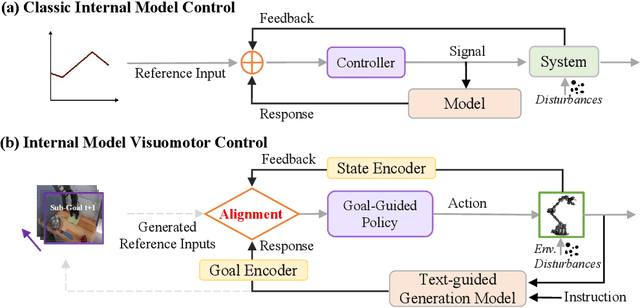
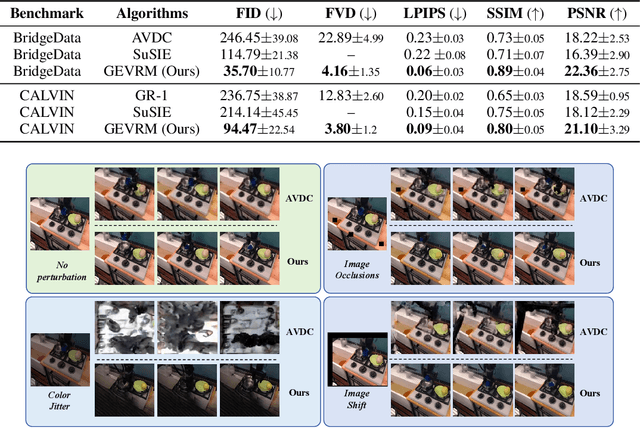
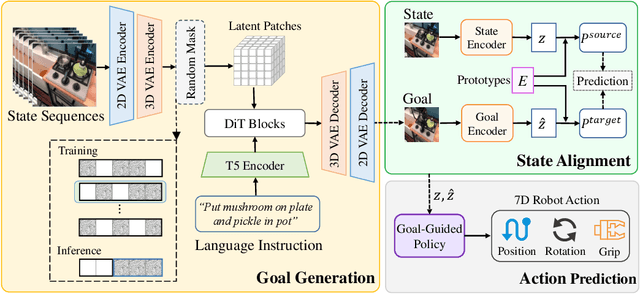

Abstract:With the rapid development of embodied artificial intelligence, significant progress has been made in vision-language-action (VLA) models for general robot decision-making. However, the majority of existing VLAs fail to account for the inevitable external perturbations encountered during deployment. These perturbations introduce unforeseen state information to the VLA, resulting in inaccurate actions and consequently, a significant decline in generalization performance. The classic internal model control (IMC) principle demonstrates that a closed-loop system with an internal model that includes external input signals can accurately track the reference input and effectively offset the disturbance. We propose a novel closed-loop VLA method GEVRM that integrates the IMC principle to enhance the robustness of robot visual manipulation. The text-guided video generation model in GEVRM can generate highly expressive future visual planning goals. Simultaneously, we evaluate perturbations by simulating responses, which are called internal embeddings and optimized through prototype contrastive learning. This allows the model to implicitly infer and distinguish perturbations from the external environment. The proposed GEVRM achieves state-of-the-art performance on both standard and perturbed CALVIN benchmarks and shows significant improvements in realistic robot tasks.
QUART-Online: Latency-Free Large Multimodal Language Model for Quadruped Robot Learning
Dec 23, 2024Abstract:This paper addresses the inherent inference latency challenges associated with deploying multimodal large language models (MLLM) in quadruped vision-language-action (QUAR-VLA) tasks. Our investigation reveals that conventional parameter reduction techniques ultimately impair the performance of the language foundation model during the action instruction tuning phase, making them unsuitable for this purpose. We introduce a novel latency-free quadruped MLLM model, dubbed QUART-Online, designed to enhance inference efficiency without degrading the performance of the language foundation model. By incorporating Action Chunk Discretization (ACD), we compress the original action representation space, mapping continuous action values onto a smaller set of discrete representative vectors while preserving critical information. Subsequently, we fine-tune the MLLM to integrate vision, language, and compressed actions into a unified semantic space. Experimental results demonstrate that QUART-Online operates in tandem with the existing MLLM system, achieving real-time inference in sync with the underlying controller frequency, significantly boosting the success rate across various tasks by 65%. Our project page is https://quart-online.github.io.
CARP: Visuomotor Policy Learning via Coarse-to-Fine Autoregressive Prediction
Dec 09, 2024



Abstract:In robotic visuomotor policy learning, diffusion-based models have achieved significant success in improving the accuracy of action trajectory generation compared to traditional autoregressive models. However, they suffer from inefficiency due to multiple denoising steps and limited flexibility from complex constraints. In this paper, we introduce Coarse-to-Fine AutoRegressive Policy (CARP), a novel paradigm for visuomotor policy learning that redefines the autoregressive action generation process as a coarse-to-fine, next-scale approach. CARP decouples action generation into two stages: first, an action autoencoder learns multi-scale representations of the entire action sequence; then, a GPT-style transformer refines the sequence prediction through a coarse-to-fine autoregressive process. This straightforward and intuitive approach produces highly accurate and smooth actions, matching or even surpassing the performance of diffusion-based policies while maintaining efficiency on par with autoregressive policies. We conduct extensive evaluations across diverse settings, including single-task and multi-task scenarios on state-based and image-based simulation benchmarks, as well as real-world tasks. CARP achieves competitive success rates, with up to a 10% improvement, and delivers 10x faster inference compared to state-of-the-art policies, establishing a high-performance, efficient, and flexible paradigm for action generation in robotic tasks.
GeRM: A Generalist Robotic Model with Mixture-of-experts for Quadruped Robot
Mar 20, 2024
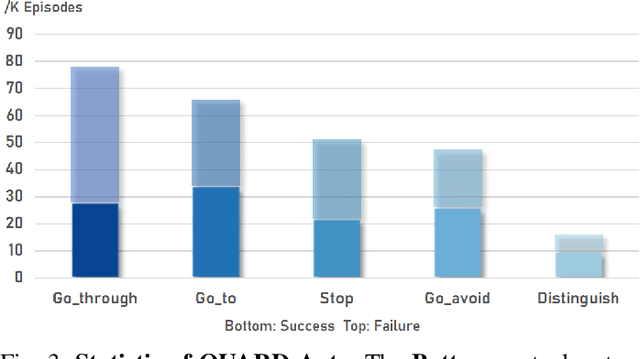


Abstract:Multi-task robot learning holds significant importance in tackling diverse and complex scenarios. However, current approaches are hindered by performance issues and difficulties in collecting training datasets. In this paper, we propose GeRM (Generalist Robotic Model). We utilize offline reinforcement learning to optimize data utilization strategies to learn from both demonstrations and sub-optimal data, thus surpassing the limitations of human demonstrations. Thereafter, we employ a transformer-based VLA network to process multi-modal inputs and output actions. By introducing the Mixture-of-Experts structure, GeRM allows faster inference speed with higher whole model capacity, and thus resolves the issue of limited RL parameters, enhancing model performance in multi-task learning while controlling computational costs. Through a series of experiments, we demonstrate that GeRM outperforms other methods across all tasks, while also validating its efficiency in both training and inference processes. Additionally, we uncover its potential to acquire emergent skills. Additionally, we contribute the QUARD-Auto dataset, collected automatically to support our training approach and foster advancements in multi-task quadruped robot learning. This work presents a new paradigm for reducing the cost of collecting robot data and driving progress in the multi-task learning community.
QUAR-VLA: Vision-Language-Action Model for Quadruped Robots
Dec 22, 2023
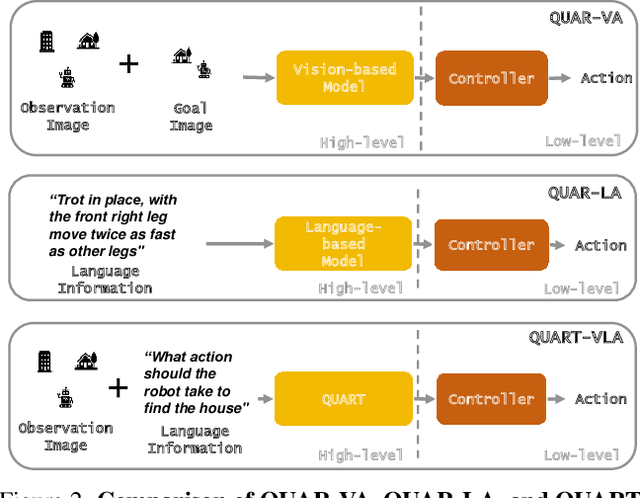

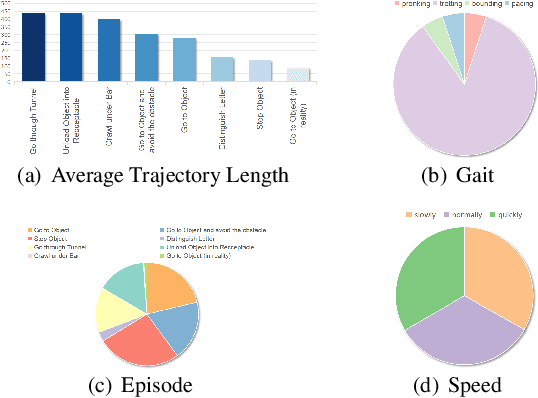
Abstract:The important manifestation of robot intelligence is the ability to naturally interact and autonomously make decisions. Traditional approaches to robot control often compartmentalize perception, planning, and decision-making, simplifying system design but limiting the synergy between different information streams. This compartmentalization poses challenges in achieving seamless autonomous reasoning, decision-making, and action execution. To address these limitations, a novel paradigm, named Vision-Language-Action tasks for QUAdruped Robots (QUAR-VLA), has been introduced in this paper. This approach tightly integrates visual information and instructions to generate executable actions, effectively merging perception, planning, and decision-making. The central idea is to elevate the overall intelligence of the robot. Within this framework, a notable challenge lies in aligning fine-grained instructions with visual perception information. This emphasizes the complexity involved in ensuring that the robot accurately interprets and acts upon detailed instructions in harmony with its visual observations. Consequently, we propose QUAdruped Robotic Transformer (QUART), a family of VLA models to integrate visual information and instructions from diverse modalities as input and generates executable actions for real-world robots and present QUAdruped Robot Dataset (QUARD), a large-scale multi-task dataset including navigation, complex terrain locomotion, and whole-body manipulation tasks for training QUART models. Our extensive evaluation (4000 evaluation trials) shows that our approach leads to performant robotic policies and enables QUART to obtain a range of emergent capabilities.
 Add to Chrome
Add to Chrome Add to Firefox
Add to Firefox Add to Edge
Add to Edge